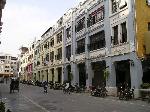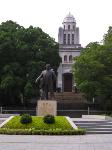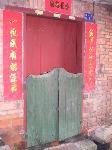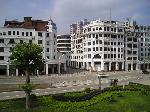- Getting around Lijiang. Dont stay in the Old Towns more than 2 days, there is nothing to do. KRISS Oct 9, 2013 05:46
- 2013 Beijing Temple Fair BENNYLAU Feb 26, 2013 03:29
- Malaysian traveling from KUL - LAX vis Shanghai PVG ZATI_DY Jan 3, 2013 20:15
Walking in Wuzhou
- Views: 4785
- |Vote: 0 0
- |Add to Favorites
- |Recommend to Friends
One of the pleasures of travel is arriving somewhere unplanned, and experiencing something special. Wuzhou was one of those places for me. Having missed the previous evening’s long haul overnight sleeper bus from Shenzhen to Beihai – and secretly relieved that I had – I opted to break my journey in Wuzhou, just over the border in Guangxi. It would be a pleasant six hour journey.
I arrived in mid afternoon expecting to jump on the next bus that afternoon to Beihai but there was not another bus until 11.300pm that night. Here was an opportunity to explore another city that I had no reason to visit except in transit and I had more than six hours to do it. So like all good explorers I didn’t miss a beat. I bought my ticket on the late bus, took my essentials from my pack, checked it at the left luggage counter, consulted my travel book and lit out for the river bank. We had been following this large river for hours and Wuzhou sits on the north bank of the very wide and very brown Xi Jiang at the junction of the Gui Jiang.
Wuzhou was opened as a foreign ‘treaty port’ way back in 1897 when the British operated a steam ship service to Guangzhou, Hong Kong and Nanning. The ‘old quarter’ or port is situated east of the Gui River. Today the original British Consulate building silently watches over the modern river traffic from White Crane Hill above the Gui River from where the newer section of town has now expanded to the west. A luxury catamaran passenger service ferries passengers between Wuzhou and Hong Kong in just eight hours. Another ferry services both Macao and Hong Kong. Wuzhou’s port is both large and modern and is considered one of the ten largest river ports in China with an annual handling capacity of over a million ton.
A recently built riverside boardwalk replete with hundreds of empty shops stretches along Xijiang Erlu to the east and west of the junction of Zhongshan Lu just across from the east bus station. A string of rusty hulks, big and small are moored below and locals lazily dip a line in anticipation of a fresh feed of fish. I stood and watched awhile in the hot afternoon sun before I succumbed to the lure of the more practical shaded footpaths of the ‘old quarter’.
Reminiscent of other treaty ports like Shanghai, Amoy (Xiamen) and Macau the remains of European architecture still very much dominate this section of the city. The narrow streets are neatly cobbled and lined with mock lantern lights, footpaths are decked with planters overflowing with colour, windows are laced with wrought iron rails and the columns and walls with decorative detail. The beautiful pastel facades of the upper floors boldly face each other across the once busy streets, quiet now, shading broad footpaths against the harsh summer sun and heavy rains. It’s a nostalgic walk through history - each doorway tells a story, hides some pain, some joys, some life, some deaths.
Overlooking the ‘old quarter’ is a small hill to the north which is the site of Zhongshan Gongyuan with the earliest memorial hall to Sun Yat Sen, the founder of the Republic of China and the Western Bamboo Temple. Walking up to the main street, Nanhuan Lu near the town square, a small square shaded by huge banyan trees the noise caught my attention. Here groups of men played cards while even larger crowds looked on cheering loudly. I kept on for higher ground – to the beautiful and cool ‘Sun Yat Sen Park’ perched on the hill overlooking the river and the city. Tall old gum trees that looked as though they belong here grace the grounds. It’s after five and still hot while I sit and watch a young couple kick a small ball for their little boy.
A shy young man approaches to have a chat. You see, they don’t see many foreigners in Wuzhou at least not many that stop for long. He’s a teacher, not of English but we understand each other. It won’t be dark for a few more hours and I want to walk the streets of Wuzhou some more before I loose the light. Outside the park I take a set of crooked stairs to my right amongst the houses and small tenement buildings down the slope. It’s nearly supper time – there’s the sound of chatter and music behind closed doors, firewood is piled high along many of the outside walls. Life is still very simple for many here.
At the bottom of the slope, the alley I’ve been following widens into a small street. I turn the corner and I’m in the market place surrounded by stalls and people and food. The market has spread into the street making progress slow and interesting. Almost everyone watches and some comment as I pass by. I make my way back to the main street past the old colonial buildings which once housed banks, offices and merchant houses. For more than a century these old buildings now in various stages of dilapidation or completely restored have stood on these blocks of cobbled streets.
I searched out a small but popular restaurant a couple of blocks from the bus station as night began to fall. I ordered my staple of easy to say dishes and watch the other diners watch me eating. I haven’t seen another foreigner all day and not likely to either. After my meal I wonder back up the now lively and well lit main street to Mac Donalds for a cup of coffee and a ‘pingguo’ apple pie. While I drink I watch. Couples, families, groups of friends come and go or walk the streets. The music is loud and so is the chatter around me. I check the time. Still two hours until the transfer bus leaves for the west bus station.
I hang about the station for the last hour with all the other people who are hanging out around the station. It’s a little quieter here. Some are sleeping. Some are collecting rubbish. Some are selling food. Some are chatting. Its’ hard to tell which ones are passengers. Motorcycles and taxis drivers wait for passengers. There’s no shortage of entertainment. By ten thirty it’s time to transfer to the other bus station. I collect by bag and head outside. I don’t want to miss this bus. It’s about a twenty minute trip to the newer, larger West bus station from where the bus to Beihai will leave at 11.30 and now just a short wait. It’s still warm outside.
Eventually the bus arrives and a small group of passengers board for the six hour journey. Some have done this before. There’s room for everyone to spread out across four seats but a girls sits down next to me. I move so I can spread out. One of the passengers hands me another blanket and helps me get comfortable. It will be a cool night despite the temperature outside. The windows fog and there’s little see. I try to sleep – I dream of laying on Beihai’s beautiful white beach in the warm tropical sun and swimming in the cool ocean water.
Not everybody’s idea of world class tourist attractions is Wuzhou’s Snake Repository but it is a major drawcard for overseas Chinese tourists. More than a million snakes pass through here each year on route to the kitchens of Hong Kong, Macau and other snake charmed destinations. You can find it on Shigu Lu about 2Kms from Wuzhou Hotel.








 Copyright © 1998-2025 All rights reserved.
Copyright © 1998-2025 All rights reserved.
1.
Sep 27, 2006 01:11 Reply
AVEY said:
welcome to our Guangxi! the people in Wuzhou speak Guangdong Hua(Cantonese,a kind of local language),have you learn some of it? Must fun!